|  
COVER STORY | GARDEN | GOOD NEWS | CALENDAR | NEWS BRIEFS
Being there:
As war looms with Iraq, protestors fill
the streets of San Francisco Story & photos by ANDREW EDWARDS In the midst of a march of thousands, tens of thousands, their signs pumping up and down like pistons in a massive anti-war machine, a daisy-chain of white prayer flags flapped delicately in the breeze. At the poles were the old, the young, the starry-eyed, the hard-bitten, veterans of protests past, veterans of foreign wars, first-time protesters (like myself), housewives, grandmothers, treesitters, everything in between. Farther down the seemingly endless stream of marchers on San Francisco's Market Street, fed by tributaries at every crossing, was Arcata City Councilman Dave Meserve, a goofy grin peeking out from under his broom of a mustache. He was holding down his 8-foot-wide balloon, its blue skin boldly declaring that "War is Way Stupid." Behind him, framed by glinting skyscrapers on either side, a banner proclaimed "So-Hum for Peace." [in photo below left] 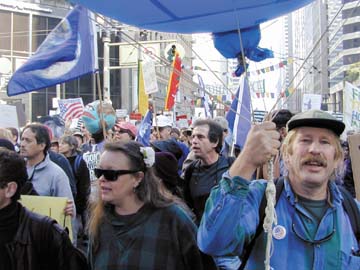 After a long drive down, the Humboldt contingent was in action, at the A.N.S.W.E.R. (Act Now to Stop War and End Racism)-organized march on the Civic Center and City Hall this past Saturday. After a long drive down, the Humboldt contingent was in action, at the A.N.S.W.E.R. (Act Now to Stop War and End Racism)-organized march on the Civic Center and City Hall this past Saturday.
For 70 of us it had begun the afternoon before at the Arcata Co-op. Mary Ann Lyons [in photo below right, near blue balloon], a longtime activist and the organizer of the trip, was busy signing people up and taking fares ($25 for a round-trip). Two buses, one gray, one yellow, stood ready, the words "Sustainable Communities Bio-Diesel Road Show" painted on their sides. Running on a cocktail of French-fry grease, methanol and diesel, these "wheels" -- provided by the Redwood Peace and Justice Center -- transport Humboldt activists to a variety of events. Eventually all the details were taken care of and we were off, the buses each roaring a grinding shimmy as they chugged into gear. Before we even got out of town brown meaty loaves from the Co-op bakery were passed around. We ate sprawled on the pads and sleeping bags strewn across the raised plywood platforms that covered the back two-thirds of the bus, smiles spreading. 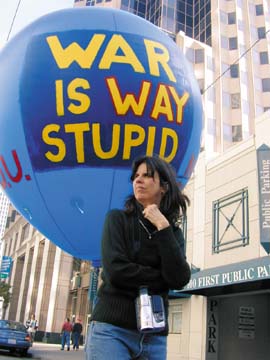 As we headed south twilight fell and then a full moon came up, its reflection visible on the Eel River. Later, skeletal branches of passing trees were bathed in the moon's ghostly silver light as the bus wound farther down Highway 101. As we headed south twilight fell and then a full moon came up, its reflection visible on the Eel River. Later, skeletal branches of passing trees were bathed in the moon's ghostly silver light as the bus wound farther down Highway 101.
In the seats up front it was forest-name central: Bee, Dragon, River and Sequoia, who had just been pulled down from his tree-sit in the "Demon" or demonstration forest, the day before. They talked of the forest and their intimate connection with the trees, but they also discussed the upcoming rally. Tigress Bergman, 15, of Arcata, a three-month veteran treesitter, explained "the hundredth monkey theory." She said that at some point ideas reach a critical mass and jump, exploding like wildfire, and become unstoppable. One person can make a difference, she said, because maybe they will be the person -- the hundredth monkey -- that sends it to the next level. It was a hopeful thought. Around 11 p.m. our caravan arrived at the Berkeley Unitarian Universalist Fellowship. Our host was Hal Carlstad, a long time activist who had been arrested more than 170 times, by his own account, including four or five times in Humboldt County. This was our lodging for the night. The next morning we left around 8:30, excitement building. "You guys are making history today," Hal said as we were packing up. In the church, beforehand, several activists discussed a "direct action" march which was to take place after the official march was over: still nonviolent but more confrontational -- and illegal.
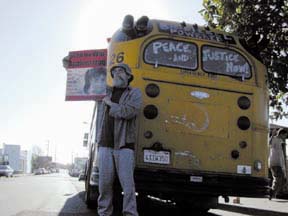 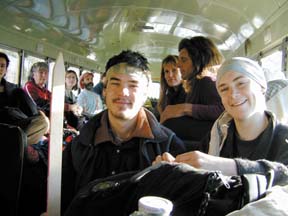
Left: Dave Short in front of the "Sustainable Communities Biodiesel Roadshow" bus, near the Arcata Co-op.
Top right: Sequoia and Dragon on the bus, heading to the march Saturday morning.
In San Francisco we unloaded at the Golden Gate University Law School, a block from Market, the designated meeting spot for the Humboldt marchers. Immediately things started happening. Signs were waved, drums were beaten. Cars, ranging from taxicabs to black Mercedes, honked as they passed. Some passengers yelled, hanging out windows and flashing peace signs. People came in from all sides; soon more Humboldt activists were on hand as a bus that had left Garberville early that morning arrived. Some motorcycle cops pulled up and told everyone to stay on the curb. I asked one of them, Officer R. Vargas according to his badge, if he expected a busy day. "Not really," he said, eyes covered by black sunglasses. "The last one [in October] was very uneventful. All we're here to do is make sure everyone gets from the Embarcadero to the Civic Center without getting hurt or without any incident. We expect it to be about the same." And with that he roared away. Finally, 11 o'clock rolled around, the official march start time, and we were off, moving down the sidewalk. Market Street was already choked with people. Music blared. Cheers rolled, crescendoing from one end of the street to the other like a gigantic vocal version of the wave. Marchers with bullhorns led people around in chants. So many were joining that the march stopped for nearly 20 minutes, stalled in the rush. The crowd was huge and mixed, a melange of faces, colors, signs and slogans. Black, white, Hispanic, gay, straight, in business suits, in black leather studded with spikes. It seemed like everyone was there. A man with a sign proclaiming he was a member of "People with portfolios against a war with Iraq" marched next to the very elderly members of the Lincoln Brigade, volunteers who had fought against Franco in the Spanish Civil War of the 1930s. "These men are very important," a woman who was taking their picture frantically explained to me. "They were the first ones to fight against fascism."
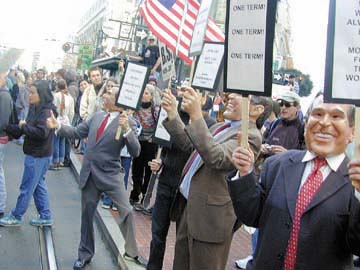 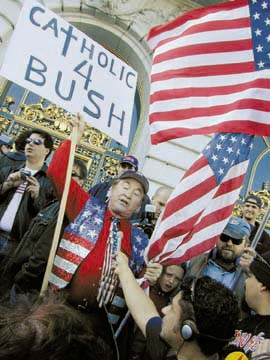
LEFT: The "Bushies" RIGHT: A representative of "Catholics for Bush" is interviewed.
A troupe of Native American dancers paraded in full regalia in front of masked marchers carrying a sign bearing anarchy symbols that declared "No War but Class War." I saw a dark-faced man from India, wearing embroidered gray robes and matching hat, holding a glinting cherry-red origami crane over his head. Behind him a girl in a black turtleneck with the neck pulled up over her nose was handing out leaflets. A young woman from A.N.S.W.E.R., her head draped in a kaffiyeh, harangued the passing crowd, urging them to donate. As we rounded the corner to the bus-lined Civic Center plaza in front of City Hall, the speakers' stage and the square around it were already packed with people. Behind the stage, which looked out over a crowd stretching as far as the eye could see, journalists, celebrity speakers and volunteers engaged in a chaotic round of questions and answers. A handler grabbed me and dragged me to the vice president of the Sierra Club, Larry Fahn. "War is the ultimate environmental atrocity," Fahn said, dressed in a red flannel shirt that looked self-consciously rustic. "We're not massing ships and planes off Korea, because [this war] is about oil. We should talk about a renewable energy future if we want real national security." In the background sang Joan Baez, who performed at the 1963 "March on Washington," the gold standard of protest events. One of the rally organizers, a Palestinian-American and San Francisco native named Jess Ghannam, talked to me about why he had gotten involved. "Palestinians are subject to a colonizing power, Israel," he said. "The U.S. is getting prepared to act in the same way in Iraq." He said twice as many people were at this rally compared to the one in the fall. The actual number was hard to guess. The official police estimate was 50,000, while the organizers estimated up to 200,000. Whatever the number, it was huge. "I'm really surprised it has come this far without a hitch," Ghannam remarked. Longtime hippie activist Wavy Gravy was speaking to a group of reporters as I passed by. "The last time we listened to a Bush we spent how many years in the desert?" he asked, his large face crinkled up in a smile. "Let's face it, we've been Bush-whacked." I climbed on stage to get a picture of the crowd as Bonnie Raitt took the stage. 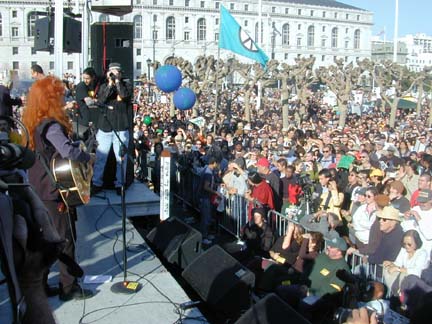
As she sang a Jackson Browne song, repeating, "The world is long on hunger, short on joy," leaning back into each chord she played on her acoustic guitar, the crowd swayed back and forth in the sunlight. It was clearly an emotional peak. Other speakers took the stage, including California Congresswoman Barbara Lee, the only member of Congress to vote in 2001 against handing George W. Bush what amounted to unchecked authority to conduct the war on terrorism. Martin Sheen also spoke, doing President Josiah Bartlet so thoroughly that afterwards he plunged into the crowd and started kissing babies. As the rally wound down, a young crowd dressed in black began to form in one corner of the plaza. As I walked by, I ran into a Humboldt activist who hadn't come down with the bus. It was Julie Ryan, a "bad-ass feminist old school punk," clad head to toe in black. She explained that this was the direct action protest I had heard about earlier. Behind us some young punks in black masks and pink mohawks were starting to burn flags, drenching them in hair spray and then torching them with lighters. Several spat on the flags as they were melting on the concrete. A leader, dressed in black from head to foot, urged the crowd to follow either a green or red banner, for tactical reasons. This was the real people's march, he declared, they didn't need a $50,000 permit (like the one A.N.S.W.E.R. had received for the main march) to take to the streets. "Whose streets? Our streets!" "One, two, three, four, we don't want your fucking war!" "Two, four, six, eight, fuck the police state!" "No justice! No peace! Take it back to the streets!" "What do we want? Class war! When do we want it? Now!" The renegade march rolled back up Market, the same street the main march had taken hours earlier. By now it was around 4 p.m. and the streets were pretty much empty. Music blared -- dub reggae and punk rock -- from a shopping cart stuffed with a generator and massive speakers draped in protest flags. After a couple of blocks they turned off Market and walked directly into traffic, past dazed commuters, some of whom cheered them on. By now the marchers were turning into vandals, breaking windows, tipping over newspaper stands and dragging them out into the street, spray-painting a parked car. A yell went up: "Only targets!" 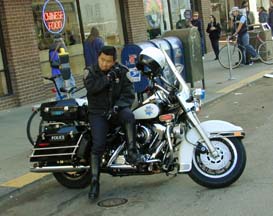 The targets were, according to one leader named Marco, the San Francisco Chronicle, the Citibank building and the INS, but other targets were decided upon and attacked along the way: Starbucks, Wells Fargo, the International Bank. The targets were, according to one leader named Marco, the San Francisco Chronicle, the Citibank building and the INS, but other targets were decided upon and attacked along the way: Starbucks, Wells Fargo, the International Bank.
All the while the police presence grew, but the officers stood back, slowly but steadily growing in number, biding their time. Finally, it happened. Plain clothes officers jumped a rowdy who was trying to kick in the window of Victoria's Secret. The crowd tried to rally to him only to be cut off by horse officers. Panic set in and people turned around and ran. The crowd dissipated. I walked back to the buses, my skin jumping with the excitement. Lyons was waiting there, at the buses with most of the passengers, some of whom were sitting in circles on the concrete, smoking. "That approach doesn't produce change, it creates resistance," she said when I told her about what had just happened. "It comes out of frustration with the inability to communicate. If you can communicate, you don't have to resort to violence." We all got on the buses, just as the sun was setting. We were bedraggled, tired, happy to have been there, and excited to have seen all of those people in one place for one purpose. Some of the people on the bus estimated that about 300 people had made it down from Humboldt County to the protest. I couldn't tell. I couldn't think. My feet hurt. It had been a hell of a day.
Postcard from Berlin:
These days, it's not easy being an American in Germany by ARNO HOLSCHUH
(photo of marchers in Heidelberg courtesy of indymedia.de) 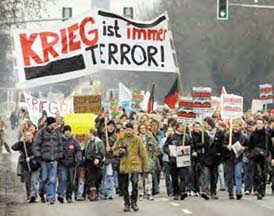 Sitting at my desk at the window of my apartment, I can see it all too clearly: A large homemade banner hanging from the window across the plaza proclaims "NO to the aggression of the USA!" I'd like to think that the sign's authors don't hold a grudge against me; after all, I'm not a big Bush fan myself. But I have my doubts. Sitting at my desk at the window of my apartment, I can see it all too clearly: A large homemade banner hanging from the window across the plaza proclaims "NO to the aggression of the USA!" I'd like to think that the sign's authors don't hold a grudge against me; after all, I'm not a big Bush fan myself. But I have my doubts.
Welcome to Berlin in January 2003, home to Europe's most vocal critics of the war in Iraq. As the drums beat louder in my home country, many people in Germany are becoming increasingly critical of all things American. If they're talking about my president, I can understand and agree. But when they have a beef with me personally, that gets sticky. And many do. Everywhere I go, I am seen as a walking, talking symbol of my country. I am constantly asked questions which I cannot possibly answer. The young man at a party asks me over the loud techno music: "Why are you attacking Iraq instead of focusing on Israel and the Palestinians?" At the grocery store, someone notices my accent and asks: "Don't you worry about the consequences for the region?" Answering is difficult, because I know where these questions are coming from. I oppose our current war plans. I know there are serious and intelligent people who believe that war is necessary, but they have yet to convince me. I think the Palestinians are being mistreated and peace is impossible until that changes. I worry that the fledgling democratic movement in Iran might be trampled underfoot in the wake of an American-led attack on Iraq. Basically, I am a typical bleeding-heart liberal when it comes to foreign affairs -- or better put, I'm a German. Because Germans hate the idea of a war. Opinion polls put the anti-war sentiment at over 80 percent, and chancellor Gerhard Schröder won the election last fall by spouting strident anti-war rhetoric. Why? It's not cowardice as such; after all, Germany has more troops in peace-keeping missions abroad than any other country besides the U.S. To put it very simply, people here have a very different understanding of what war can cost than we do. That's not necessarily bad, in my view; Germans understand war's ravages because they brought them upon themselves in two world wars. Americans should be proud that our country was never that ruthless, murderous or insane. But consider this: If America was "at war" in the same way that Germans understand the phrase, it wouldn't just be the WTC that was reduced to rubble. It would be most of Manhattan, and the rest of our major cities as well. The largest cities in Germany were more than 80 percent destroyed by Allied bombing. Major government buildings in Berlin are still pockmarked from bullets by Soviet soldiers 58 years ago. Very few people here are angry about that; this is a country that has by and large been forced to face its past and accept its guilt. But people are conscious of what bombs and house-to-house fighting are like, and they are reluctant to visit that hell on anyone. They cannot understand why we are so eager to do so. It is this "we" that bugs me the most. I write columns for a newspaper here in which I try to get Germans to differentiate between different types of Americans, or better yet, see us as individuals. Some Americans, myself for example, speak German. Many more speak Spanish. More of us voted for Gore than for Bush, and in my view it was largely after the shock of Sept. 11 that we rallied behind the "Cowboy from Texas," as Bush is sometimes called here. And when you explain that to a Berliner, they generally nod in understanding. Then they'll ask: What about those Republicans? You can hear that they're just dying for me to pin the blame on someone. This is the hardest part -- getting the message across to Germans that Republicans are among the nicest people you will ever meet. Working as a reporter for two years in Humboldt taught me this much: You can disagree with every political position a person has and still enjoy his or her jokes. Most people here just don't get it; they've never hitchhiked Highway 299 to Redding, so there's no way they can know that only right-wingers in pickup trucks are nice enough to give you a ride. Of course, not everyone immediately equates my American accent -- which Germans say sounds like I'm trying to speak with potatoes in my mouth -- with the Bush administration. This is an incredible city, and you can find critical thinking in the most unexpected of places. In Café Zapata, a bar with brick walls and a left-wing clientele, I was approached by a scruffy young man who had obviously had one too many Becks. "Hello. You are American?" he asked in a slurring German. "Yes, why?" "Because I have to tell you something. I love America. I love Americans. You saved Berlin from the communists. I hope you have a wonderful time in Berlin and are happy here." "Thank you!" I said. It was not what I had expected. "But there is one thing," he added, fingering his bottom lip and staring at the cigarette butts littering the floor. "Yes?" "I hate your government." I could only agree. Arno Holschuh is a former Journal staff writer.
Back to NEWS BRIEFS
COVER STORY | GARDEN | GOOD NEWS | CALENDAR | NEWS BRIEFS Comments? E-mail the Journal: [email protected] 
© Copyright 2003, North Coast Journal, Inc. |